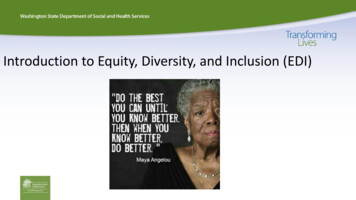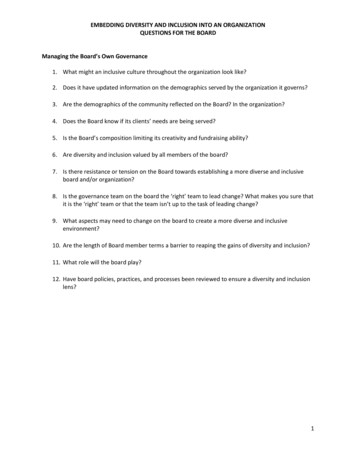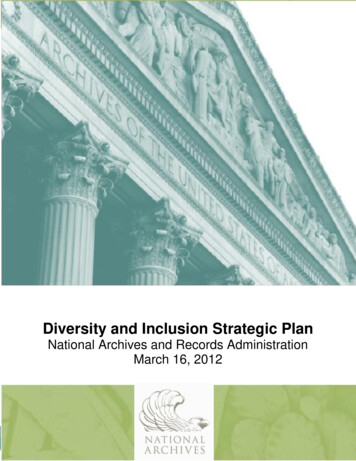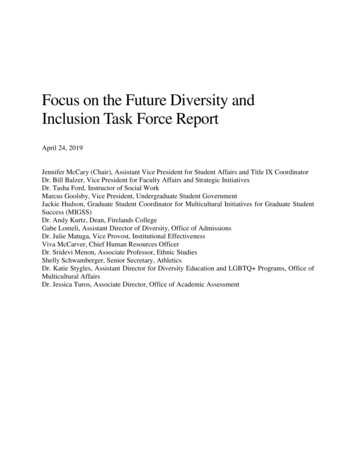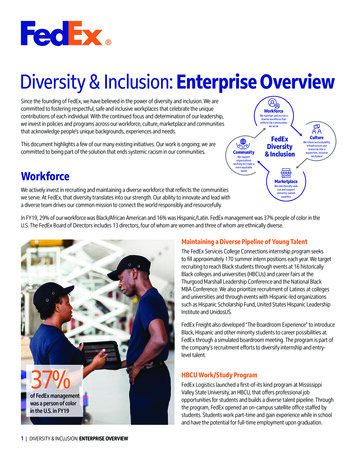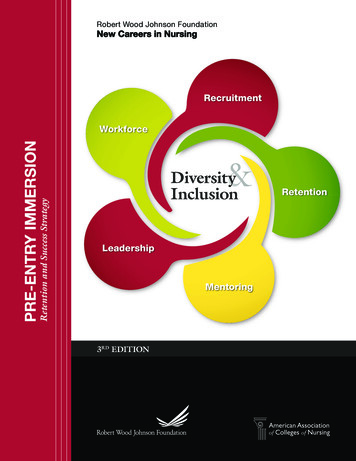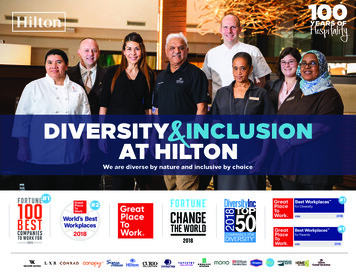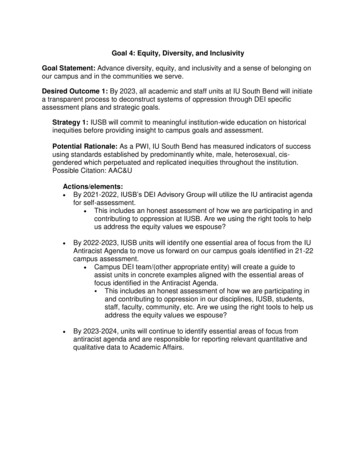
Transcription
Diversity, Equity, andInclusion PlanMichigan Department of Health and Human ServicesDeveloped by: MDHHS Diversity CommitteeApproved May 2018
Diversity, Equity, andInclusion PlanMissionTo promote and foster a culture that values diversity, equity, and inclusion throughout the MichiganDepartment of Health and Human Services and the diverse communities we serve in order to achieveour highest potential.VisionDiversity, as reflected in our leadership and throughout our workforce, offers a valuable range ofexperiences and perspectives. Our diverse workforce will be an essential asset for developing andproviding health and human services that are culturally proficient to address existing and emerginghealth and social issues.DefinitionsDiversity:The range of human differences, abilities, experiences, and perspectives.Inclusion:A culture that fosters diversity, equity, support, and respect within every facet of organizational servicesand activities.Equity:Fair and just treatment, access and opportunities for all people while building better outcomes forhistorically and currently disadvantaged populations.Systemic Inequities:Unequal outcomes built into a system that will produce inequality even in the absence of individualbiases. Some examples include, but are not limited to, racism, sexism, heterosexism, ableism, andageism.IntroductionIn 2015, the departments of Community Health and Human Services merged forming the unifiedMichigan Department of Health and Human Services (MDHHS). Prior to the merger, both departmentshad developed and were implementing their own diversity plans. In order to create a unified plan, acommittee was formed in 2016 with representation from all administrations within the department.This dedicated team worked diligently to develop a unified proposal that clearly demonstrates thedepartment’s continued commitment to eliminate systemic inequities and promote diversity, equity,and inclusion. The result of committee’s work is this Diversity, Equity, and Inclusion plan. Ourcommittee recognized that a lack of workforce diversity and inclusion is often the result of past andcurrent practices - systemic inequities - which must be addressed.1
Diversity, Equity, andInclusion PlanThis document represents key actions the committee is recommending the department take towardachieving diversity, equity, and inclusion in the areas of Leadership, Culture and Climate, Recruiting andHiring, Training and Professional Development, and Service Delivery. Each of these action items will besubject to thorough financial and policy reviews.Committee MembersLance Bettison – Human Resources, Dr. Sharon Bland-Brady – Disability Determination Services, AshiyaBrown – Medical Services Administration, Mike Derose – Human Resources, Nickco Dixon – MichiganRehabilitation Services, Dale Freeman – Field Operations Administration, Stacie Gibson – Office ofWorkforce Development and Training, Vicki Grant – Human Resources, Michele Harper – Office ofWorkforce Development and Training, Mary Beth Kern-Collins – Legal Affairs, Geralyn Lasher – ExternalAffairs and Communications, Tracie Lewis-Jennings – Michigan Rehabilitation Services, Tari Muniz –Aging and Adult Services Agency, Colin Murad – Workforce Engagement and Transformation, ShellyMurrell – Workforce Engagement and Transformation, Jemar Sutton – Children’s Services Agency,Rashmi Travis – Population Health Administration, Jessica Van Winkle – Financial OperationsAdministration, Sheryl Weir – Policy, Planning, and Legislative Services, Brant Wimbush – Office ofWorkforce Development and Training/MAGE, Lynda Zeller – Behavioral Health and DevelopmentalDisabilities AdministrationStatement of PurposeThis proposed plan was developed to embody the values of diversity, equity, and inclusion as well asalign with the Strategic Priorities of the Michigan Department of Health and Human Services. This workis necessary to improve outcomes for employees, communities, stakeholders, and customers byaddressing inequities at a systemic level. Upon implementation, it will improve the understanding andmutual respect of those our employees work for, with, or around; improve customer relations; makeMDHHS a more competitive inclusive employer in the job market; boost employee morale, professionaldevelopment, and retention; encourage multiple perspectives to ensure creative problem solving; allowgreater transparency; and ensure that all cultures, backgrounds, and experiences are valued in our everchanging diverse workforce.Equity ApproachOur approach to achieving diversity, equity, and inclusion is rooted in principles of racial equity. Wehave chosen to have an intentional but not exclusive focus on race as a way to address systemic racismand other forms of oppression and exclusion. A racial equity approach allows us to design policies,practices, and strategies that result in fair and equitable opportunities for everyone. Using thisapproach compels us: 1) to understand the historic and current drivers of health and social inequalitiese.g. racism, sexism, heterosexism, ableism, ageism; 2) to identify how MDHHS contributes to, and candeconstruct these inequalities; 3) to work in partnership with the communities we serve to achieve2
Diversity, Equity, andInclusion Planequity; 4) to use statistical data to assess and monitor the impact of diversity, equity and inclusioninitiatives on the workforce; 5) to monitor the effectiveness of our efforts; and 6) to ensuresustainability. This approach will be utilized by all administrations within MDHHS.A key element of the department’s strategy is to train in and encourage the use of an equity assessmenttool that will guide the decision making process for evaluating the potential impacts of existing andfuture policies and programs. Best practice indicates that an equity assessment process should includethe following lines of inquiry: Proposal - What is the policy, program, practice or budget decision under consideration? What arethe desired results and outcomes?Data - What’s the data? What does the data tell us?Community Engagement - How have communities been engaged? Are there opportunities toexpand engagement?Analysis and Strategies - Who will benefit from or be burdened by your proposal? What are yourstrategies for advancing equity or mitigating unintended consequences?Implementation - What is your plan for implementation?Accountability and Communication - How will you ensure accountability, communicate, andevaluate results? 1Opportunities and ChallengesThere are already a number of existing efforts this proposal will support and collaborate with including,but not limited to: The Office of Workforce Development and Training has established a Race Equity Team that isworking on multiple strategies to address systemic inequities and advance equitable outcomesDepartment Leadership’s Strategic Alignment Team who have identified Equity as a priority in 2018The Health Equity Steering Committee whose work has been improving the department for over 15yearsThe MDHHS Diversity, Equity, and Inclusion Plan provides additional opportunities as well as recognizespotential challenges. Below are some strategies intended to proactively address barriers to successfulimplementation: Ensure buy-in and support from all department leaders and supervisors.Commit to the efficient use of available budgetary and human resources to accomplish plan goalswhile advocating for greater allocations as needed.1Nelson, J. & Brooks, L. (2015). Racial Equity Toolkit: An Opportunity to Operationalize Equity. GovernmentAlliance on Race and Equity. Retrieved February 3, 2018 from: 2015/10/GARE-Racial Equity Toolkit.pdf.3
Diversity, Equity, andInclusion Plan Establish clear metrics and measurement tools to track the impact and effectiveness of the diversity,equity and inclusion plan.Promote a culture of individual responsibility as a key element of systemic change.An essential part of the success of the proposed plan is the creation a Diversity, Equity, and InclusionCouncil. This group of employees appointed by department leadership will be led by the newly createdDiversity, Equity, and Inclusion Officer recommended in this proposal. The Council will overseeimplementation of this proposal and ensure an ongoing commitment to the principles of this proposalon a permanent basis. The Council will serve as an advisory body to the MDHHS Director, Chief DeputyDirector, Human Resources, and executive-level leaders in fostering an environment of diversity, equity,and inclusion throughout the agency. The Council will work to develop relationships with internal andexternal stakeholders and serve as advocates to promote and share information throughout and outsidethe agency in regards to diversity, equity, and inclusion initiatives.Indicators for SuccessLeadership Outcomes Leaders at all levels have completed the established Diversity, Equity, and Inclusion leadershiptraining.Leadership develops and implements strategies and prioritizes resources to ensure Diversity, Equity,and Inclusion Plan objectives are met to achieve fair and equitable outcomes.Appoint a Diversity, Equity, and Inclusion Officer responsible for the implementation andimprovement of the Diversity, Equity, and Inclusion Plan.Leaders will support the efforts of the Diversity, Equity, and Inclusion Council.Culture and Climate Outcomes Employees are aware and respectful of the department’s diversity, equity, and inclusion efforts.Identify organizations with experience eliminating systemic inequities to help us strengthen ourdiversity, equity, and inclusion initiatives.Communication with our customers occurs in the language of their choice and meets NationalCulturally and Linguistically Appropriate Services Standards. 2Feedback from customers, community partners, stakeholders, and employees is incorporated in ourdecision-making and implementation procedures.2U.S. Department of Health and Human Services, Office of Minority Health. (n.d.). National Standards for Culturallyand Linguistically Appropriate Services (CLAS) in Health and Health Care. Retrieved February 6, 2018 /pdfs/EnhancedNationalCLASStandards.pdf.4
Diversity, Equity, andInclusion PlanRecruiting, Hiring and Retention Outcomes Our workforce, including leadership, is diverse and talented.Hiring managers receive education and assistance to ensure that our hiring practices are consistentand transparent.Applicant pools are diverse and reflect the demographics of the communities we serve.Positions that serve communities with limited English proficiency are filled by staff fluent in theirlanguage.Prospective and current employees are aware of our reasonable accommodation policies,procedures, and resources.Training and Professional Development Outcomes Our employees are engaged in equitable work practices, such as designing and delivering programsin a culturally and linguistically appropriate manner, and are committed to our department’sdiversity, equity, and inclusion goals.A core group of diversity, equity, and inclusion subject matter experts has been established tosupport training and professional development implementation throughout the department.Employees have received diversity, equity, and inclusion training and are prepared to establish theseprinciples as core priorities for how the department carries out its mission.Employees are able to identify and reduce implicit bias and systemic inequities.Service Delivery Outcomes Systemic bias in our department’s policies and procedures have been identified and eliminated.Our vendors, service providers, and stakeholders assist the department’s efforts to address systemicinequities by collaborating with our diversity, equity, and inclusion plans.Underserved populations are well represented in the department’s vendors and service providers.ConclusionThe Michigan Department of Health and Human Services will continue to hold Diversity, Equity, andInclusion as essential values to support our core Mission, Vision, and Values. Addressing issues ofdiversity, equity, and inclusion is the work of us all. As an organization we will implementrecommendations in this proposal through the commitment by department leadership, the Diversity,Equity, and Inclusion Council, and action teams consisting of representation across the department.Systemic inequities cannot be eliminated by the actions of a few. Our success is dependent onemployees and partners of MDHHS taking strong positive action for the culture to change. This proposalprovides employees throughout MDHHS the tools and education to build a more culturally inclusiveworkforce that is accountable to the communities that we serve.5
This dedicated team worked diligently to develop a unified proposal that clearly demonstrates the department’s continued commitment to eliminate systemic inequities and promote diversity, equity, and inclusion. The result of committee’s work is this Diversity, Equity, and Inclusion plan. Our committee recognized that a lack of workforce diversity and inclusion is often the result of past .
